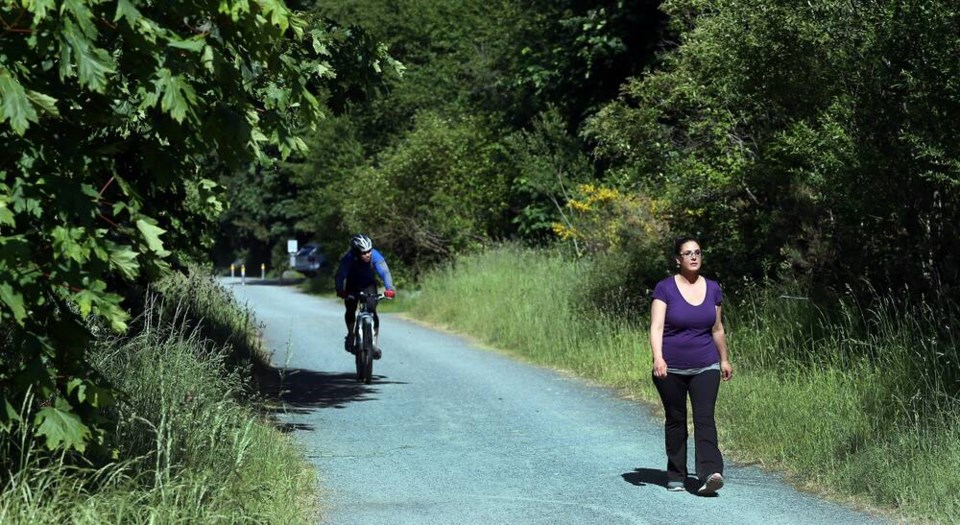Walking on the left, out of the way
We have started, as have others, to walk on the left side facing traffic when on shared-use pathways, just as we do on roadways without sidewalks.
We move to single file and to the left edge when encountering the highly variable types of vehicles present, now including high-speed powered ones.
Do we ever cause a situation where they have to stop? No. Do we dart across the path in front of them? Of course not.
It’s better for everyone. We can see them and they can see us.
We would certainly consider moving back to the right if cyclists behind us would consistently reveal their presence by bell or voice. I doubt, though, that’s going to start any time soon.
Thomas Ambler
Esquimalt
Feeling safer on the left side of the trail
I think most people walk on the right side on multi-use trails because that is what we are asked to do.
I’m wondering though, if the majority really feel comfortable walking on the right side.
I do not, but I follow the requirement. Makes me feel quite vulnerable to cyclists coming up from behind.
As a pedestrian, I would much rather walk on the left side, whether on a road or multi-use trail such as the Lochside, facing oncoming traffic whether it be cars or bicycles.
As a cyclist, I’m happier when people walking on the same side as I am riding, are facing me and we can make eye contact.
Shelley Andrews
Cordova Bay
Taxpayers deserve better health care
Over the past few weeks, many news articles have been reporting on our failing health-care system. Most are requesting that in one way or another the government should increase funding, especially for doctors and front-line workers.
Let’s be clear. The government doesn’t fund anything, it is the taxpayers who fund the health-care system.
Governments don’t have any money that they haven’t taken from the taxpayers in the first place. The government is basically an administrator of the funds entrusted to it by the taxpayers.
Unfortunately, they are obviously not doing a very good job of it.
Vast amounts of money are provided to the health system by individuals and corporations that donate literally millions of dollars to hospital foundations, cancer, heart, lung and other foundations and charitable organizations.
Without these funds and organizations, patients would be far worse off than they are presently.
It seems that the system is broken and needs a complete overhaul from the top to the bottom. A study should be undertaken at once to review our system and come up with practical alternatives.
The study should not be bound by preconceived and politically motivated rules and regulations. The bottom line must be to provide our citizens with the best, most efficient and economically viable health-care system that their money can provide.
Bev Highton
Oak Bay
Medical school seats will not keep up
Let’s assume we create 100 additional medical school graduates per year.
After medical school, all physicians complete a residency. In 2021, about 42 per cent of new physicians ended up in a family medicine residency somewhere in Canada.
So of the 100 new medical doctors, we created 42 new family physicians and 58 new specialists. This is only the beginning of the bad news.
Once they finish a residency in family medicine, we need to convince them to participate in community-based, longitudinal primary care. This is the outcome people are looking for.
We know from a 2018 study that somewhere around 30 per cent of current family physicians are practising this kind of medicine on a full-time basis. This is even worse for new graduates, where anecdotally this is between five per cent and 15 per cent.
So our hypothetical new medical school minted 100 shiny new physicians, and we ended up with 42 new family physician residents. Ultimately, only somewhere between two and 12 new family doctors ended up attaching patients in a family practice.
This doesn’t account for the small army of physicians who need to contribute to the education of medical students and resident physicians, already exhausted themselves, and unlikely to say yes to another demand on their time.
Let there be no mistake: a new medical school is a distraction if you don’t make the job of a family physician more appealing in the first place. It wouldn’t even keep up with attrition.
Sean Birdsell
Victoria
School budget cuts play same old song
Here we go again! It always seems that when it comes to school district budget cuts, one of the first cuts is to the funding of music lessons in our schools.
This despite the many reports and surveys outlining the many benefits of participating in music lessons.
The time has come for less emphasis on sport in the schools, and by doing so, cut the sport budget by 20 per cent.
Jennifer Shore
Victoria
Nanoose Bay has hiking, golf, more
It was very hard for me to believe that, according to the new Discover magazine, we have lost Nanoose Bay.
It is not shown on any of the six maps showing Nanaimo and Parksville. It has just disappeared.
Not one word about Nanoose Bay, or its wonderful marina and golf course, or its incredible hiking and biking trails and the fact that it is one of the finest scuba diving areas on the Island.
It appears that it only exists for those that do not want the noise and traffic of Nanaimo and Parksville yet is only 15 minutes away from both and for those who truly enjoy all water and land activities and sporting activities.
Maybe we will make the “must see” group next year.
David Campbell
Nanoose Bay
(wherever that is)



